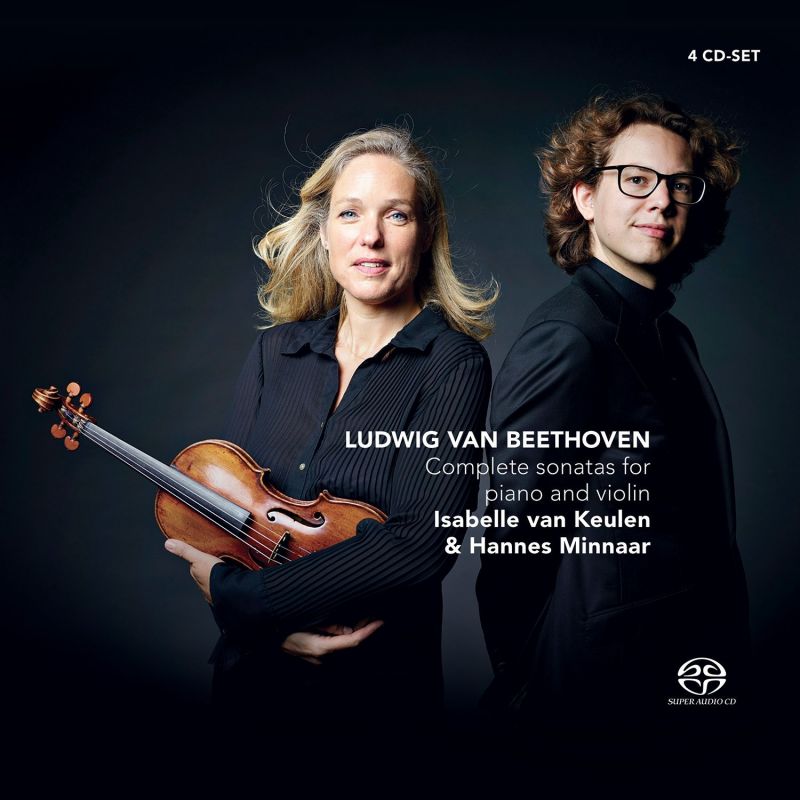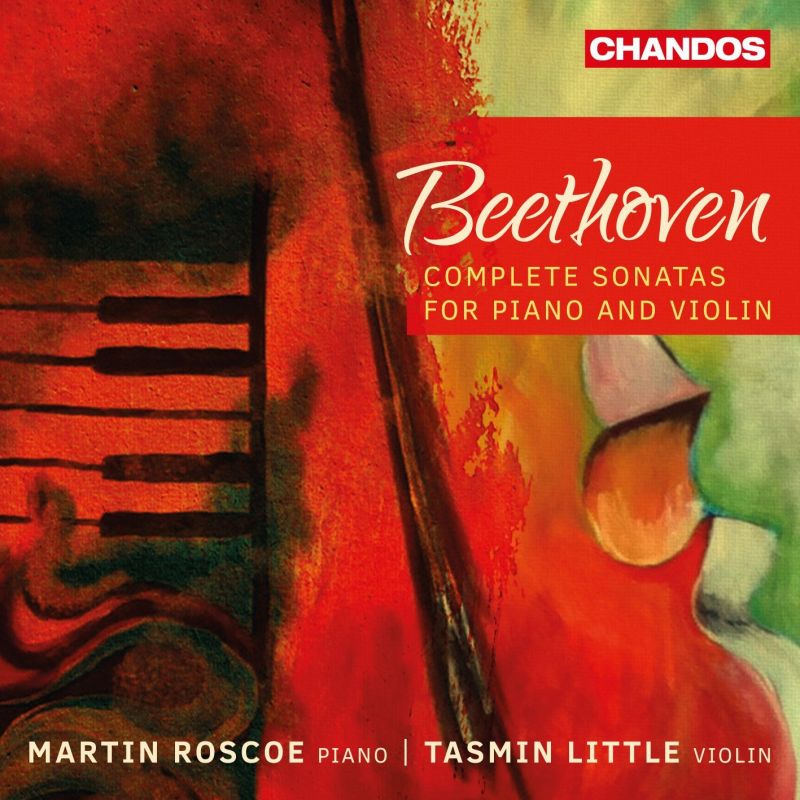BEETHOVEN Complete Violin Sonatas
View record and artist detailsRecord and Artist Details
Composer or Director: Ludwig van Beethoven
Genre:
Chamber
Label: Challenge Classics
Magazine Review Date: 03/2016
Media Format: CD or Download
Media Runtime: 222
Mastering:
DDD
Catalogue Number: CC72650

Tracks:
| Composition | Artist Credit |
|---|---|
| Sonata for Violin and Piano No. 1 |
Ludwig van Beethoven, Composer
Hannes Minnaar, Piano Isabelle van Keulen, Violin Ludwig van Beethoven, Composer |
| Sonata for Violin and Piano No. 2 |
Ludwig van Beethoven, Composer
Hannes Minnaar, Piano Isabelle van Keulen, Violin Ludwig van Beethoven, Composer |
| Sonata for Violin and Piano No. 3 |
Ludwig van Beethoven, Composer
Hannes Minnaar, Piano Isabelle van Keulen, Violin Ludwig van Beethoven, Composer |
| Sonata for Violin and Piano No. 4 |
Ludwig van Beethoven, Composer
Hannes Minnaar, Piano Isabelle van Keulen, Violin Ludwig van Beethoven, Composer |
| Sonata for Violin and Piano No. 5, 'Spring' |
Ludwig van Beethoven, Composer
Hannes Minnaar, Piano Isabelle van Keulen, Violin Ludwig van Beethoven, Composer |
| Sonata for Violin and Piano No. 6 |
Ludwig van Beethoven, Composer
Hannes Minnaar, Piano Isabelle van Keulen, Violin Ludwig van Beethoven, Composer |
| Sonata for Violin and Piano No. 7 |
Ludwig van Beethoven, Composer
Hannes Minnaar, Piano Isabelle van Keulen, Violin Ludwig van Beethoven, Composer |
| Sonata for Violin and Piano No. 8 |
Ludwig van Beethoven, Composer
Hannes Minnaar, Piano Isabelle van Keulen, Violin Ludwig van Beethoven, Composer |
| Sonata for Violin and Piano No. 9, 'Kreutzer' |
Ludwig van Beethoven, Composer
Hannes Minnaar, Piano Isabelle van Keulen, Violin Ludwig van Beethoven, Composer |
| Sonata for Violin and Piano No. 10 |
Ludwig van Beethoven, Composer
Hannes Minnaar, Piano Isabelle van Keulen, Violin Ludwig van Beethoven, Composer |
Composer or Director: Ludwig van Beethoven
Genre:
Chamber
Label: Chandos
Magazine Review Date: 03/2016
Media Format: CD or Download
Media Runtime: 238
Mastering:
DDD
Catalogue Number: CHAN10888

Tracks:
| Composition | Artist Credit |
|---|---|
| Sonata for Violin and Piano No. 1 |
Ludwig van Beethoven, Composer
Ludwig van Beethoven, Composer Martin Roscoe, Piano Tasmin Little, Violin |
| Sonata for Violin and Piano No. 2 |
Ludwig van Beethoven, Composer
Ludwig van Beethoven, Composer Martin Roscoe, Piano Tasmin Little, Violin |
| Sonata for Violin and Piano No. 10 |
Ludwig van Beethoven, Composer
Ludwig van Beethoven, Composer Martin Roscoe, Piano Tasmin Little, Violin |
| Sonata for Violin and Piano No. 3 |
Ludwig van Beethoven, Composer
Ludwig van Beethoven, Composer Martin Roscoe, Piano Tasmin Little, Violin |
| Sonata for Violin and Piano No. 6 |
Ludwig van Beethoven, Composer
Ludwig van Beethoven, Composer Martin Roscoe, Piano Tasmin Little, Violin |
| Sonata for Violin and Piano No. 7 |
Ludwig van Beethoven, Composer
Ludwig van Beethoven, Composer Martin Roscoe, Piano Tasmin Little, Violin |
| Sonata for Violin and Piano No. 8 |
Ludwig van Beethoven, Composer
Ludwig van Beethoven, Composer Martin Roscoe, Piano Tasmin Little, Violin |
| Sonata for Violin and Piano No. 4 |
Ludwig van Beethoven, Composer
Ludwig van Beethoven, Composer Martin Roscoe, Piano Tasmin Little, Violin |
| Sonata for Violin and Piano No. 5, 'Spring' |
Ludwig van Beethoven, Composer
Ludwig van Beethoven, Composer Martin Roscoe, Piano Tasmin Little, Violin |
| Sonata for Violin and Piano No. 9, 'Kreutzer' |
Ludwig van Beethoven, Composer
Ludwig van Beethoven, Composer Martin Roscoe, Piano Tasmin Little, Violin |
Author: Harriet Smith
Whether you want a pianist who can read your every thought or whether sparks fly better when you combine opposing characters is a moot point. Throughout the Faust/Melnikov cycle, for instance, you’re acutely aware of two fundamentally different musical personalities, yet that tension is what makes their readings so fascinating. Little and Roscoe, by contrast, come across as being very attuned to one another, taking a notably cajoling approach to the first movement of Op 30 No 3, for instance; van Keulen and Minnaar strike me as being somewhere in the middle – their more manic reading of the same movement has a precision-engineered reactivity. Little and Roscoe bring out the cantabile quality of the slow movement of Op 30 No 2 effectively; van Keulen and Minnaar are a tad brisker here. But for a truly sumptuous reading you need to experience Dumay and Pires – warm and yielding yet never self-consciously so.
The opening of the Spring (No 5) is always an interesting point of comparison. I like van Keulen’s fragility, though her accented rising notes (disc 2, tr 4, 1'36") are slightly raw in tone. She tends to pare off her vibrato much more than Little, incidentally, giving rise to very different sound worlds. But the pay-off is that, though Little’s sound is never less than rounded, she can sometimes come across as too considered, diminishing vital momentum, and sometimes the violin passagework is too prominent in the balance. In the finale the conversation between Little and Roscoe is a little stilted owing to their steady speed, but they judge the Scherzo to a nicety; compared to them, van Keulen and Minnaar sound too safe.
The brief Scherzo of the last Sonata, Op 96, also finds Little more explosive than van Keulen, though Faust is more dramatic still. Its slow movement is one of the greatest Beethoven ever wrote, and neither Roscoe nor Minnaar can quite match Melnikov in the piano’s opening, endlessly detailed yet always maintaining a clarity of vision. I like van Keulen’s approach to the finale, though – a little brisker than Little’s and ultimately more exuberant.
The particular brand of fantasy in the Kreutzer suits Little and Roscoe particularly well and from its Bachian solo-violin opening onwards there’s a real fire to the first movement, sometimes veering on the edgy side tonally, but always compelling. Van Keulen seems more restrained, emotionally speaking, and the movement itself has a more sectionalised feel to it. In its finale both Roscoe and Minnaar are on terrific form, though of the two string players, Little’s fuller sound is more appealing to these ears. In the end, though, neither new set challenges the finest modern-day versions: Dumay uses the accents of the finale to drive the music forwards in the most compelling way; Faust conjures up the most powerful sense of mournfulness in the sonata’s solo opening; while Ibragimova in the same passage is equally moving in the way she allows each phrase to fade away.
In the more Classically conceived Op 12 Sonatas, it is often van Keulen who is the more compelling, Little tending to sound a little too Romantic (just sample the outset of Op 12 No 1, or the second variation of its slow movement, where Little smoothes over its more skittish moments). The winsome finale of Op 12 No 2 – such a highlight of the Dumay/Pires set – sounds a tad underenergised in the hands of Little and Roscoe. Or take the Allegro con spirito opening of the last of the Op 12 sonatas: infectiously dispatched by Ibragimova and Tiberghien, Little trades madcap for elegant, while van Keulen and Minnaar tread a middle ground, conveying an insouciant glee. Both new releases are well recorded and annotated but, in the last resort, there are even finer offerings from Dumay, Faust and Ibragimova, to name just three.
Discover the world's largest classical music catalogue with Presto Music.

Gramophone Digital Club
- Digital Edition
- Digital Archive
- Reviews Database
- Full website access
From £8.75 / month
Subscribe
Gramophone Full Club
- Print Edition
- Digital Edition
- Digital Archive
- Reviews Database
- Full website access
From £11.00 / month
Subscribe
If you are a library, university or other organisation that would be interested in an institutional subscription to Gramophone please click here for further information.




